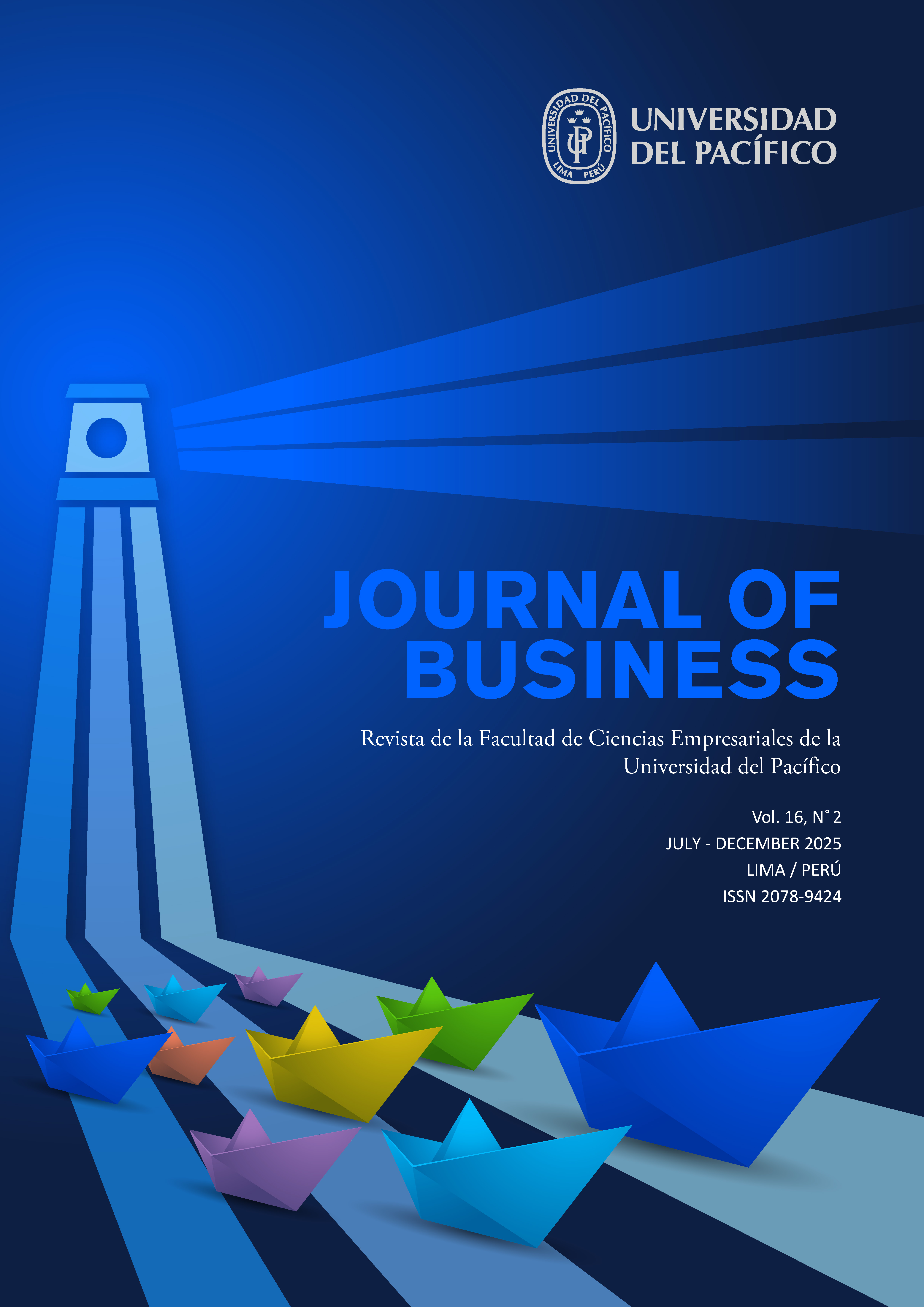La presencia del estado en la empresa y la presencia del estado en la economía de destino de exportación: un análisis de empresas colombianas
DOI:
https://doi.org/10.21678/jb.2025.2483Palabras clave:
State presence; hybrid firms; export destination; Colombia; export diversificationResumen
Esta investigación analiza la relación entre la presencia del estado dentro de las empresas y la presencia del estado en las economías de destino de exportación, así como el papel moderador de la diversificación de exportaciones en esta relación entre ambas manifestaciones de la presencia estatal. Se plantea la hipótesis de que existe una relación positiva entre la presencia del estado dentro de las empresas y su presencia en la economía de destino de exportación, y que la diversificación de exportaciones tiene un papel moderador negativo. A pesar del proceso continuo de mercantilización, liberalización y privatización en las economías emergentes, la presencia del estado dentro de una empresa mejora su capacidad de exportación, especialmente hacia países con una alta presencia estatal. Sin embargo, cuando dicha empresa exporta a varios destinos, disminuye sus exportaciones hacia países con alta presencia estatal. El estudio se basó en la teoría institucional y en datos de empresas colombianas entre 2009 y 2016.
Descargas
Citas
Aggarwal, R. and Agmon, T. 1990. The International Success of Developing Country
Firms: Role of Government-Directed Comparative Advantage. MIR: Management
International Review, 30, 163-180.
Aguilera, R. V., Ciravegna, L., Cuervo-Cazurra, A. and Alejandra Gonzalez-Perez, M.
2017. Multilatinas and the internationalization of Latin American firms. Journal of
World Business, 52, 447-460.
Baggs, J. and Brander, J. A. 2006. Trade liberalization, profitability, and financial leverage.
Journal of International Business Studies, 37, 196-211.
Barnett, W. P. and Mckendrick, D. G. 2004. Why are Some Organizations More Competitive
than Others? Evidence from a Changing Global Market. Administrative
Science Quarterly, 49, 535-571.
Berry, H., Guillen, M. F. and Zhou, N. 2010. An institutional approach to cross-national
distance. Journal of International Business Studies, 41, 1460-1480.
Boehe, D. M., Qian, G. and Peng, M. W. 2016. Export intensity, scope, and destinations:
Evidence from Brazil. Industrial Marketing Management, 57, 127-138.
Brenes, E. R., Ciravegna, L. and Marcotte, P. 2016. Assessing agri-business firms’ performances:
Organizational and marketing business models of high/low sales and ROE
outcomes. Journal of Business Research, 69, 3415-3426.
Bruton, H. J. 1998. A reconsideration of import substitution. Journal of Economic Literature,
36, 903-936.
Buck, T., Filatotchev, I., Demina, N., and Wright, M. 2000. Exporting activity in transitional
economies: An enterprise-level study. Journal of Development Studies, 37(2),44-66.
Buckley, P. J., Clegg, L. J., Cross, A. R., Liu, X., Voss, H. and Zheng, P. 2007. The Determinants
of Chinese Outward Foreign Direct Investment. Journal of International
Business Studies, 38, 499-518.
Burke, A., and Hussel, S. 2013. How competition strengthens start-ups. Harvard Business
Review, 91, 24.
Cantwell, J., Dunning, J. H. and Lundan, S. M. 2010. An evolutionary approach to understanding
international business activity: The co-evolution of MNEs and the institutional
environment. Journal of International Business Studies, 41, 567-586.
Cuervo-Cazurra, A. 2006. Who Cares about Corruption. Journal of International Business
Studies, 37, 807-822.
Cuervo-Cazurra, A. 2012. Extending theory by analyzing developing country multinational
companies: Solving the Goldilocks debate. Global Strategy Journal, 2, 153-167.
Cuervo-Cazurra, A. and Dau, L. A. 2009a. Promarket Reforms and Firm profitability in
Developing Countries. Academy of Management Journal, 52, 1348-1368.
Cuervo-Cazurra, A. and Dau, L. A. 2009b. Structural Reform and Firm Exports. MIR:
Management International Review, 49, 479-507.
Cuervo-Cazurra, A. and Genc, M. 2008. Transforming Disadvantages into Advantages:
Developing-Country MNEs in the Least Developed Countries. Journal of International
Business Studies, 39, 957-979.
Cui, L. and He, X. 2017. Expanding near the home base or venture far? The influence of
home country state on the economic distance of foreign direct investments. Journal
of Business Research, 75, 95-107.
Delios, A. and Henisz, W. J. 2000. Japanese firms’ investment strategies in emerging economies.
Academy of Management Journal, 43, 305-323.
Demir, F., and Hu, C. (2020). Destination institutions, firm heterogeneity and exporter
dynamics: empirical evidence from China. Review of World Economics, 156(1),
183-217.
Deng, Z., Jean, R.-J. B. and Sinkovics, R. R. 2017. Rapid expansion of international new
ventures across institutional distance. Journal of International Business Studies.
Dong, G., Kokko, A., and Zhou, H. (2022). Innovation and export performance of emerging
market enterprises: The roles of state and foreign ownership in China. International
Business Review, 31(6), 102025.
Dorobantu, S., Kaul, A., and Zelner, B. (2017). Nonmarket strategy research through the
lens of new institutional economics: An integrative review and future directions.
Strategic Management Journal, 38(1), 114-140.
George, G., Wiklund, J. and Zahra, S. A. 2005. Ownership and the Internationalization of
Small Firms. Journal of Management, 31, 210-233.
Ghemawat, P. 2001. Distance still matters - The hard reality of global expansion. Harvard
Business Review, 79, 137-+.
Goerzen, A. and Beamish, P. W. 2003. Geographic scope and multinational enterprise
performance. Strategic Management Journal, 24, 1289-1306.
Greenaway, D., Guariglia, A. and Kneller, R. 2007. Financial factors and exporting decisions.
Journal of International Economics, 73, 377-395.
Guillen, M. F. and Garciacanal, E. 2009. The American Model of the Multinational Firm
and the “New” Multinationals from Emerging Economies. Academy of Management
Perspectives, 23, 23-35.
Hitt, M. A., Hoskisson, R. E. and Kim, H. 1997b. International diversification: effects on
innovation and firm performance in product diversified firms. Academy of Management
Journal, 40, 767-798.
Hong, J., Wang, C. and Kafouros, M. 2015. The Role of the State in Explaining the Internationalization
of Emerging Market Enterprises. British Journal of Management,
26, 45-62.
Hoskisson, R. E., Eden, L., Lau, C. M. and Wright, M. 2000. Strategy in Emerging Economies.
Academy of Management Journal, 43, 249-267.
Hutzschenreuter, T. and Guenther, F. 2008. Performance effects of firms’ expansion paths
within and across industries and nations. Strategic Organization, 6, 47-81.
Inoue, C. F. K. V., Lazzarini, S. G. and Musacchio, A. 2013. Leviathan as a Minority
Shareholder: Firm-Level Implications of State Equity Purchases. Academy of Management
Journal, 56, 1775-1801.
Iyer, D. N. and Miller, K. D. 2008. Performance Feedback, Slack, and The Timing of
Acquisitions. Academy of Management Journal, 51, 808-822.
Jackson, G. and Deeg, R. 2008. Comparing Capitalisms: Understanding Institutional
Diversity and its Implications for International Business. Journal of International
Business Studies, 39, 540-561.
Khandelwal, A., Schott, P. K. and Wei, S. 2012. Trade Liberalization and Embedded Institutional
Reform: Evidence from Chinese Exporters.
Khanna, T. and Palepu, K. 2000. The Future of Business Groups in Emerging Markets: Long-
Run Evidence from Chile. The Academy of Management Journal, 43, 268-285.
Khanna, T., Palepu, K. G. and Sinha, J. 2005. Strategies that fit emerging markets. Harvard
Business Review, 83, 63-+.
Kim, J. and Daniels, J. D. 1991. Marketing Channel Decisions of Foreign Manufacturing
Subsidiaries in the U.S.: The Case of the Metal and Machinery Industries. MIR:
Management International Review, 31, 123-138.
Kotabe, M., Teegen, H., Aulakh, P. S., De Arruda, M. C. C., Santillan-Salgado, R. J. and
Greene, W. 2000. Strategic alliances in emerging Latin America: A view from Brazilian,
Chilean, and Mexican companies. Journal of World
Lawless, M. 2010. Geography and firm exports: new evidence on the nature of sunk costs.
Review of World Economics, 146, 691-707.
Lee, C. and Beamish, P. W. 1995. The Characteristics and Performance of Korean Joint
Ventures in LDCS. Journal of International Business Studies, 26, 637-654.
Lewin, A. Y. and Volberda, H. W. 1999. Prolegomena on Coevolution: A Framework for
Research on Strategy and New Organizational Forms. Organization Science, 10,
519-534.
Liang, H., Ren, B. and Sun, S. L. 2015. An Anatomy of State Control in the Globalization
of State-Owned Enterprises. Journal of International Business Studies, 46, 223-
240.
Liu, L. 1993. Entry-Exit, learning and productivity change - Evidence from Chile. Journal
of Development Economics, 42, 217-242.
Lopez, L., Kundu, S. K. and Ciravegna, L. 2009. Born Global or Born Regional? Evidence
from an Exploratory Study in the Costa Rican Software Industry. Journal of International
Business Studies, 40, 1228-1238.
Luo, Y., Xue, Q. and Han, B. 2010. How emerging market governments promote outward
FDI: Experience from China. Journal of World Business, 45, 68-79.
Mcdougall, P. P. and Oviatt, B. M. 2000. International Entrepreneurship: The Intersection
of Two Research Paths. Academy of Management Journal, 43, 902-906.
Meyer, K. E. and Peng, M. W. 2016. Theoretical Foundations of Emerging Economy Business
Research. Journal of International Business Studies, 47, 3-22.
Ministerio de Comercio, I. Y. T. D. C. 2017. Superintendencia de Sociedades [Online].
Available: http://www.supersociedades.gov.co/ [Accessed 2018].
Ministerio de Hacienda de Colombia. 2012. Dirección de Impuestos y Aduanas Nacionales
[Online]. Available: http://www.dian.gov.co/ [Accessed 2018].
North, D. C. 2005. Understanding the Process of Economic Change.
Palepu, K. 1985. Diversification strategy, profit performance and the entropy measure.
Strategic Management Journal,
Peng, M. W. 2003. Institutional Transitions and Strategic Choices. Academy of Management
Review, 28, 275-296.
Piercy, N. 1981. British export market selection and pricing. Industrial Marketing Management,
10, 287-297.
Powell, W. W., Koput, K. W. and Smith-Doerr, L. 1996. Interorganizational Collaboration
and the Locus of Innovation: Networks of Learning in Biotechnology. Administrative
Science Quarterly, 41, 116-145.
Qian, G., Khoury, T. A., Peng, M. W. and Qian, Z. 2010a. THE PERFORMANCE
IMPLICATIONS OF INTRA- AND INTER-REGIONAL GEOGRAPHIC
DIVERSIFICATION. Strategic Management Journal, 31, 1018–1030.
Qian, G., Khoury, T. A., Peng, M. W. and Qian, Z. 2010b. The Performance Implications
of Intra- and Inter-Regional Geographic Diversification. Strategic Management
Journal, 31, 1018-1030.
Ramasamy, B., Yeung, M. C. H. and Laforet, S. 2012. China’s outward foreign direct
investment: Location choice and firm ownership. Journal of World Business, 47,
17-25.
Robins, F. China: A new kind of ‘mixed’ economy? Asian Bus Manage 9, 23–46 (2010).
https://doi.org/10.1057/abm.2009.21
Rugman, A. M. and Verbeke, A. 2004. A perspective on regional and global strategies of
multinational enterprises. Journal of International Business Studies, 35, 3-18.
Tallman, S. and Li, J. T. 1996. Effects of international diversity and product diversity
on the performance of multinational firms. Academy of Management Journal, 39,
179-196.
The Heritage Foundation. 2018. Index of Economic Freedom [Online]. Available: https://
www.heritage.org/ [Accessed].
The World Bank. 2006. Doing Business-Measuring business regulations [Online]. Available:
http://www.doingbusiness.org/rankings [Accessed 2016].
The World Bank. 2017. The World Bank in Colombia [Online]. Available: http://www.
worldbank.org/en/country/colombia/overview#1 [Accessed 2018].
Universidad de Pennsylvania. 2018. Distance Data [Online]. The Lauder Institute. Available:
https://lauder.wharton.upenn.edu/resources-publications/ [Accessed 2018].
Vega Salas, W. G. and Deng, Z. 2017. High ownership concentration and exporting of
emerging market firms: evidence from Peru. Frontiers of Business Research in
China, 11, 17.
Volberda, H. W. and Lewin, A. Y. 2003. Co-evolutionary Dynamics Within and Between
Firms: From Evolution to Co-evolution. Journal of Management Studies, 40,
2111-2136.
Wan, W. P. 2005. Country Resource Environments, Firm Capabilities, and Corporate
Diversification Strategies. Journal of Management Studies, 42, 161-182.
World Bank. 2018c. The Worldwide Governance Indicators (WGI) project [Online].
Available: http://info.worldbank.org/governance/wgi/index.aspx#home [Accessed
2018].
Wu, J., and Zhao, H. (2015). The dual effects of state ownership on export activities of
emerging market firms: An inducement–constraint perspective. Management
International Review, 55, 421-451.
Xuefeng, Q., and Yasar, M. (2016). Export market diversification and firm productivity:
Evidence from a large developing country. World Development, 82, 28-47.
Zhang, C.m., and Greve, H. R. (2019). Dominant coalitions directing acquisitions: Different
decision makers, different decisions. Academy of management Journal, 62(1),
44-65.
Zheng, W., Singh, K. and Mitchell, W. 2015. Buffering and enabling: The impact of interlocking
political ties on firm survival and sales growth. Strategic Management Journal,
36, 1615-1636.



